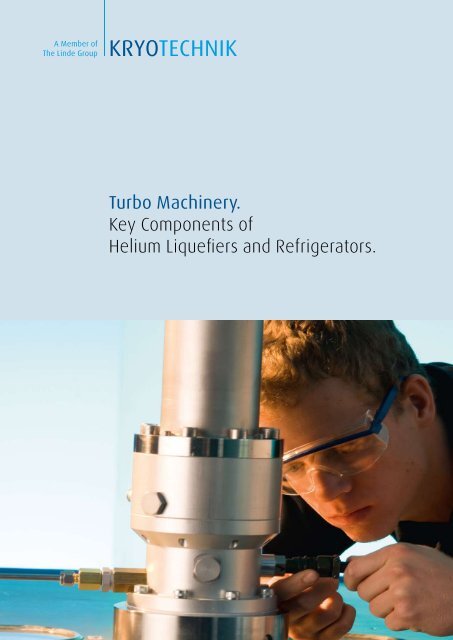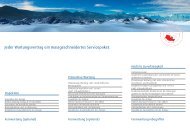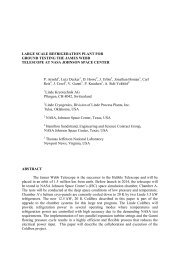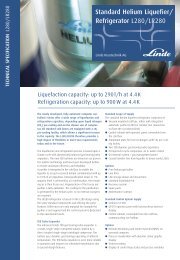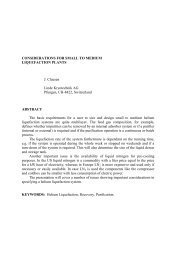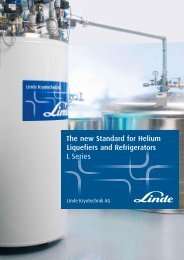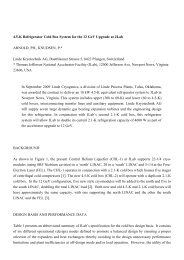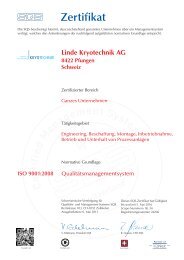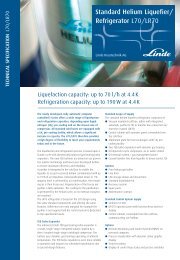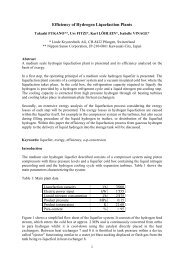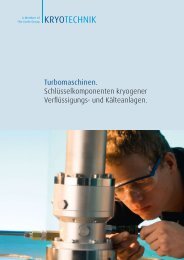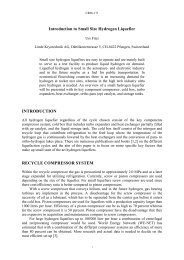Turbo Machinery - Linde Kryotechnik AG
Turbo Machinery - Linde Kryotechnik AG
Turbo Machinery - Linde Kryotechnik AG
Create successful ePaper yourself
Turn your PDF publications into a flip-book with our unique Google optimized e-Paper software.
A Member of<br />
The <strong>Linde</strong> Group<br />
KRYOTECHNIK<br />
<strong>Turbo</strong> <strong>Machinery</strong>.<br />
Key Components of<br />
Helium Liquefiers and Refrigerators.
<strong>Turbo</strong> <strong>Machinery</strong><br />
Expansion turbines with dynamic gas bearings.<br />
Reliability that counts.<br />
<strong>Linde</strong> <strong>Kryotechnik</strong> <strong>AG</strong> has more than<br />
30 years of experience in the development,<br />
manufacturing and operation of expansion<br />
turbines with dynamic gas bearings for use<br />
in cryogenic gas processes. The turbines are<br />
used to generate refrigeration power with<br />
gases such as helium, hydrogen, nitrogen<br />
and neon. Worldwide, more than 1,000<br />
expansion turbines of <strong>Linde</strong> <strong>Kryotechnik</strong> <strong>AG</strong><br />
are successfully used in refrigeration units<br />
and liquifiers. The user community includes<br />
industrial plants, universities and research<br />
facilities like CERN, DESY, ORNL, JLab and<br />
Fermilab.<br />
The expansion turbines in a refrigeration or<br />
liquefaction plant are actuated by the pressurized<br />
working gas, which consequently cools<br />
down. The expansion turbines convert pressure<br />
into mechanical performance and therefore<br />
function as refrigerating machines.<br />
Energy extracted from the process gas is<br />
dissipated completely in the turbine’s brake<br />
compression cycle. The heat generated in<br />
the brake compressors is released at ambient<br />
temperature to the cooling water system.<br />
The <strong>Linde</strong> expansion turbine is a single-stage<br />
radial-flow turbine. It is connected via the<br />
turbine shaft directly to a radial brake compressor.<br />
The rotational speed of the turbine is<br />
controlled by means of the brake compressor<br />
working point.<br />
A special feature is the expansion turbine’s<br />
innovative dynamic gas bearing system.<br />
In contrast to static gas bearings, dynamic<br />
gas bearings are self-supporting, that is, an<br />
external supply of bearing gas is unnecessary.<br />
The turbine thus works at a high efficiency<br />
since the entire<br />
amount of gas is<br />
available for the<br />
actual refrigeration<br />
process. Furthermore,<br />
in comparison to static<br />
gas bearings, leakage flow 1<br />
of warm gas into the expansion<br />
stage of the turbine is<br />
eliminated. The dynamic gas<br />
bearing-supported turbine is<br />
thus characterized by an outstanding<br />
low heat inleak. Compared to<br />
oil bearings, dynamic gas bearings<br />
eliminate the risk of oil contamination<br />
of the process gas.<br />
A turbine control system permanently monitors<br />
the operating status of the turbine and adjusts<br />
it to its optimum working point, that is, to its<br />
optimal rotational speed, via a control valve<br />
in the brake compression cycle. The turbine’s<br />
control logic is integrated into the plant control<br />
system and comprises safety functions which<br />
protect the expansion turbine, e.g. against<br />
overspeed.<br />
Due to its modular design, assembly and<br />
disassembly of the expansion turbine as well<br />
as an exchange of the turbine inlet filter can<br />
be carried out without breaking the insulating<br />
vacuum of the Coldbox.<br />
<strong>Linde</strong> expansion turbines with dynamic<br />
gas bearings are characterized by a simple<br />
and robust design, a high efficiency, high<br />
operational safety and reliability, as well<br />
as a very long service life. Because of their<br />
wear-free operation, periodic inspections are<br />
unnecessary.<br />
8<br />
4<br />
9<br />
6<br />
1.<br />
2.<br />
3.<br />
4.<br />
5.<br />
6.<br />
7.<br />
8.<br />
9.<br />
5<br />
3<br />
7<br />
Brake circuit cooler<br />
Speed sensor<br />
Turbine cartridge<br />
Brake wheel<br />
Turbine wheel<br />
Gas inlet<br />
Gas outlet<br />
Control valve<br />
Low temperature casing<br />
2
Kalte Kompressoren<br />
Cold compressors<br />
Maximum performance.<br />
Today, cold compressors from<br />
<strong>Linde</strong> <strong>Kryotechnik</strong> <strong>AG</strong> are used in a wide<br />
array of cryogenic systems.<br />
Cold compressors compress gas at cryogenic<br />
temperatures. Depending on the required<br />
final pressure several cold compressors<br />
can be connected in series. Moreover, with<br />
cold compressors it is possible to create<br />
sub atmospheric process conditions, e.g. for<br />
generating near-absolute zero superfluid<br />
helium (< 4.2 K).<br />
The use of cold compressors in medium-sized<br />
refrigeration units is very cost-efficient, in<br />
large-sized units indispensable. Due to the<br />
compression of subatmospheric process gas,<br />
the essential advantage here lies in a drastic<br />
reduction in the sizes of downstream equipment<br />
such as vacuum pumps, compressors,<br />
and heat exchangers.<br />
The cold compressors consist of a radial flow<br />
compression stage, a cryogenic housing and<br />
an electrical drive unit with integrated bearing<br />
assembly. For optimized operation of the<br />
radial flow compression stage, the electrical<br />
drive is speed-controlled. The overall system is<br />
characterized by a modular design. Assembly<br />
and disassembly of the cold compressor can<br />
be carried out without breaking the insulating<br />
vacuum of the Coldbox.<br />
The machines developed by <strong>Linde</strong> <strong>Kryotechnik</strong> <strong>AG</strong><br />
are designed for the individual process<br />
con ditions of the respective system.<br />
The cold compressors of <strong>Linde</strong> <strong>Kryotechnik</strong> <strong>AG</strong> are characterized by the following:<br />
• high thermodynamic (polytropic) efficiency<br />
• high compression ratio<br />
• broad operational range<br />
• minimum heat inleak, optionally with a helium or nitrogen shield<br />
• operational safety due to the advanced control concept<br />
• precise speed control of the high-performance drive for working at different operation points<br />
• standardized components for easy replacement<br />
• extremely low-maintenance
Cold circulators<br />
Efficient distribution of cold.<br />
Cold circulators are used to cool system<br />
components which are spatially separate<br />
from the refrigeration unit.<br />
1 Liquefier<br />
2 Compressor<br />
3 Oil Removal System<br />
4 Buffer Tank<br />
5 Pressure Control Panel<br />
6 Dewar<br />
Cold circulators transport cryogenic helium<br />
from the refrigeration unit to the point<br />
of use. Typically, cold circulators are used<br />
to supply large cooling mass flows to the<br />
consumer.<br />
One particular application of cold circulators<br />
is also the requirement of strictly separating<br />
primary and secondary cooling circuits in<br />
nuclear equipment systems as for example in<br />
a cold neutron source (CNS, UCN).<br />
Cold circulators consist of a pumping stage, a<br />
cryogenic housing and an electrical drive unit<br />
with integrated bearing assembly.<br />
7 Mobile Dewar<br />
8 Line Drier<br />
9 Stand-alone Control Panel<br />
10 H.P. Recovery Compressor<br />
11 Cylinder Bundle<br />
12 Gas Bag<br />
The pump wheel is driven via a speedcontrolled<br />
electric motor. The overall system is<br />
characterized by its modular design.<br />
Assembly and disassembly of the cold circulator<br />
are possible without breaking the insulating<br />
vacuum of the Coldbox.<br />
The machines developed by <strong>Linde</strong> <strong>Kryotechnik</strong> <strong>AG</strong><br />
are designed for the individual process<br />
con ditions of the respective system.<br />
The cold circulators of <strong>Linde</strong> <strong>Kryotechnik</strong> <strong>AG</strong> are characterized by the following:<br />
• high thermodynamic (polytropic) efficiency<br />
• broad operational range<br />
• minimum heat inleak, optionally with a nitrogen or helium shield<br />
• compact design, a high degree of stability, and long operating periods<br />
• precise speed control of the high-performance drive for working at different operation points<br />
• standardized components for easy replacement<br />
• extremely low-maintenance operation
Lorem Ipsum<br />
www.linde-kryotechnik.ch info@linde-kryotechnik.ch
<strong>Linde</strong> <strong>Kryotechnik</strong> <strong>AG</strong><br />
Daettlikonerstrasse 5<br />
CH-8422 Pfungen<br />
Switzerland<br />
Phone: +41.52.304 05 55<br />
Fax: +41.52.304 05 50<br />
info@linde-kryotechnik.ch<br />
www.linde-kryotechnik.ch<br />
A Member of<br />
The <strong>Linde</strong> Group<br />
Technical Performance.<br />
Turbine Expander Type<br />
Turbine Expander Type TED16 TED22 TED32 TED45<br />
Max. Process Power 5 kW 10 kW 25 kW 50 kW<br />
Cold compressors and cold circulators<br />
<strong>Linde</strong> <strong>Kryotechnik</strong> reserves the right to make changes without prior notice, in particular when design and engineering changes are made to<br />
improve functionality and when errors have occurred in descriptions and images.<br />
Service and Sales Partners<br />
China<br />
<strong>Linde</strong> <strong>AG</strong>, LE Division<br />
Beijing Representative Office<br />
Room 401, Lido Commercial Building<br />
Jichang Road, Beijing 100 004, China<br />
Phone +86.10.6437 67 22<br />
+86.10.6437 66 34<br />
Fax +86.10.6437 67 18<br />
<strong>Linde</strong>China@vip.163.com<br />
India<br />
<strong>Linde</strong> Engineering India Pvt. Ltd.<br />
38, Nutan Bharat Society, Alkapuri,<br />
Vadodara - 390007, Gujarat, India<br />
Phone +91.265.305 67 89<br />
Fax +91.265.233 52 13<br />
sales@linde-le.com<br />
www.linde-india.com<br />
KRYOTECHNIK<br />
Cold compressors Cold circulators<br />
Min. Flow Rate 10 g/s 100 g/s<br />
Max. Flow Rate on request on request<br />
Suction Pressure 15 mbar > 3 bar<br />
Max. Pressure Difference — 2.5 bar<br />
Compression Ratio per Stage up to 4 —<br />
Polytropic Shaft Efficiency 70% – 85% * 70% – 85% *<br />
Shield Cooling / Thermal Intercept optional optional<br />
Codes and Standards ASME, AD 2000 and others ASME, AD 2000 and others<br />
* as a function of the design point<br />
Japan<br />
Taiyo Nippon Sanso Corporation<br />
Plant Engineering Center<br />
Space & Cryogenic Equipment<br />
6-2 Kojima-Cho,<br />
Kawasaki-Ku Kanagawa Pref.<br />
210-0861 Kawasaki-City, Japan<br />
Phone +81.442.88 53 06<br />
Fax +81.442.88 27 27<br />
takashi.fukano@tn-sanso.co.jp<br />
www.tn-sanso.co.jp<br />
Koike Sanso Kogyo Co.<br />
3-1 Shinden 2 Chome<br />
272 Ichikawa City, Chiba, Japan<br />
Phone +81.473.76 36 33<br />
Fax +81.473.76 70 20<br />
t.fushimi@koikeox.co.jp<br />
www.koikeox.co.jp<br />
Mexico, USA and Canada<br />
<strong>Linde</strong> Cryogenics<br />
Division of <strong>Linde</strong> Process Plants, Inc.<br />
6100 South Yale Avenue<br />
Suite 1200<br />
Tulsa, Oklahoma 74136, USA<br />
Phone +1.918.477 1200<br />
Fax +1.918.477 1100<br />
lindecryogenics@lppusa.com<br />
www.lppusa.com<br />
12345678 0102 – 1.1 xy


